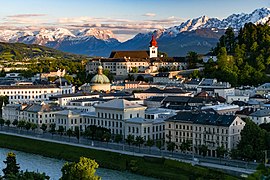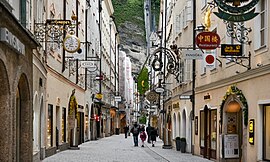Salzburg
Salzburg | |
|---|---|
|
From top, left to right: view ofHohensalzburg Fortress,University of Salzburgin front of theSalzach,withNonnberg Abbeyin the background,Salzburg Cathedral,Roittner-Durchhaus,Getreidegasse | |
|
| |
| Coordinates:47°48′0″N13°02′0″E/ 47.80000°N 13.03333°E | |
| Country | |
| State | Salzburg |
| District | Statutory city |
| Government | |
| •Mayor | Harald Preuner (ÖVP) |
| Area | |
| • Total | 65.65 km2(25.35 sq mi) |
| Elevation | 424 m (1,391 ft) |
| Population (1 October 2020)[2] | |
| • Total | 157,245 |
| • Density | 2,400/km2(6,200/sq mi) |
| Time zone | UTC+1(CET) |
| • Summer (DST) | UTC+2(CEST) |
| Postal code | 5020 |
| Area code | 0662 |
| Vehicle registration | S |
| Website | www |
| UNESCO World Heritage Site | |
|---|---|
 | |
| Criteria | Cultural: ii, iv, vi |
| Reference | 784 |
| Inscription | 1996 (20thSession) |
| Area | 236 ha |
| Buffer zone | 467 ha |
Salzburg(Austrian German:[ˈsaltsbʊɐ̯k];German:[ˈzaltsbʊɐ̯k](![]() listen);[note 1]literally "Salt Fortress";Austro-Bavarian:Soizbuag) is the capital and also a district of the Austrian state of Salzburg orSalzburgerland.Thepopulationis about 150,000 and is the 4th largest city of Austria.
listen);[note 1]literally "Salt Fortress";Austro-Bavarian:Soizbuag) is the capital and also a district of the Austrian state of Salzburg orSalzburgerland.Thepopulationis about 150,000 and is the 4th largest city of Austria.
Its most famous citizen wasWolfgang Amadeus Mozart.Another famous inhabitant of Salzburg was the physicistChristian Dopplerwho found theDoppler effectwhich was named after him.
The Salzach river crosses the city. The old town was adopted by theUNESCOasWorld Heritage Sitein 1996. Known is Salzburg also for being one of the settings for the movie "The Sound of Music" which based on the musical by Richard Rodgers and Oscar Hammerstein.
History
[change|change source]People lived in Salzburg since the NewStone Agetill present. The oldest finding in the city area is dated around 4500 B.C. From 15 B.C. onwards after the Roman occupation the city was called Iuvavum. The roman city was in today's old town around the Waagplatz. The city became an important place from the east to the province of Germania. The Romans left on the beginning of the barbarian migration around 500. Up to 696 only little can be said about the history. In 696 the city was given to bishop Rupert by Duke Theodo II. of Bavaria.
Rupert was ordered by the Duke to bring Christianity to the east and southeast of his country. Rupert founded the monastery St. Peter and for women the monastery Nonnberg. 739 Salzburg became the seat of a bishop and 774 the first cathedral was built. 998 Salzburg became archbishopric ruling the whole Bavarian area.
In the Middle Ages Salzburg became wealthy by the trade with salt from the nearbyDürnberginHallein.Till the 14th century Salzburg became independent from Bavaria and was a state within theHoly Roman Empire.The citizens of Salzburg were under the command of the archbishop unlike other cities in the empire. In the baroque era the look of today's city was shaped. The cathedral was rebuilt in the baroque style. Most of the architects came from Italy. 1622 a university was founded. Due to the fact that it was a catholic state Protestants had a severe standing in Salzburg. Yet 1731 Protestants, who came not back to the catholic belief had do leave Salzburg within eight days.
In the early 19th centuryNapoleon Bonapartepromoted the Duchy of Salzburg, than later was a part of the Kingdom ofBavaria.Then, Salzburg was annexed by Austria, returned to Bavarian and divided between Bavaria and Austria. 1918 Salzburg became a federal state of the new Republic of Austria.
In 1938,GermanyannexedAustria and Salzburg was a part of Germany. In 1945, when Austria was independent from Germany. It became a federal state again.
Urban districts
[change|change source]
Urban districts (Stadtteile):
- Aigen
- Altstadt
- Elisabeth-Vorstadt
- Gneis
- Gneis-Süd
- Gnigl
- Itzling
- Itzling-Nord
- Kasern
- Langwied
- Lehen
- Leopoldskron-Moos
- Liefering
- Maxglan
- Maxglan-West
- Morzg
- Mülln
- Neustadt
- Nonntal
- Parsch
- Riedenburg
- Salzburg-Süd
- Taxham
- Schallmoos
Mayors of the city since it became part of Austria
[change|change source]1816 - 1875
[change|change source]- Magistratwithout mayor1816bis1818
- Anton von Heffter1818-1831
- Alois Lergetporer1831-1847
- Mathias Gschnitzer1847-1850
- Franz Xaver Späth1850-1853
- Alois Spängler1854-1861
- Heinrich Ritter von Mertens1861-1872
- Ignaz Harrer1872-1875
1875 - 1919
[change|change source]- Rudolf Biebl1875-1885
- Leopold Scheibl1885-1888
- Albert Schumacher1888-1890
- Franz von Hueber1890-1894
- Gustav Zeller1894-1898
- Eligius Scheibl1898-1900
- Franz Berger1900-1912
- Max Ott1912-1919
1919 bis 1945
[change|change source]- Josef Preis1919-1927
- Max Ott1927-1935
- Richard Hildmann1935-1938
- Anton Giger,1938-1945- „Oberbürgermeister der Gauhauptstadt Salzburg “during Nazi occupation
1945 bis 1999
[change|change source]- Richard Hildmann1945-1946
- Anton Neumayr1946-1951
- Stanislaus Pacher1952-1957
- Alfred Bäck1957-1970
- Heinrich Salfenauer1970-1980
- Josef Reschen1980-1990
- Harald Lettner1990-1992
- Josef Dechant1992-1999
Mayor elected directly by the people from 1999 onwards
[change|change source]- Heinz Schadensince1999
Monuments
[change|change source]Salzburg is aWorld Heritage.There are some places of interest like:
- Altstadt (Old City) with
Other places of interest
[change|change source]- Mirabell Palace with Mirabell Garden
- Augustiner Bräustübl Mülln (beer garden of the Augustiner brewery)
- Hellbrunn palace
-
St. Peters cemetery
-
Festspielhaus
-
Fortress Hohensalzburg
-
Kollegienkirche
-
Fountain on the Residenzplatz
-
Getreidegasse
-
Mirabell gardens with fortress in the background
-
Schloss Mirabell and gardens
Famous citizens
[change|change source]- Wolfgang Amadeus Mozart,composer
- Gerhard Amanshauser,writer
- Gerd Bacher,journalist
- Christian Doppler,mathematician and physicist
- Herbert von Karajan,conductor
- Angelika Kirchschlager,singer
- Genia Kühmeier,singer
- Hans Makart,painter
- Georg Trakl,lyric poet
- Irma von Troll-Borostyáni,early feminist
Sister cities
[change|change source] Reims,France,since1964
Reims,France,since1964 Atlanta,USA,since1967
Atlanta,USA,since1967 Verona,Italy,since1973
Verona,Italy,since1973 Dresden,Germany,since1991
Dresden,Germany,since1991 Kawasaki,Japan,since1992
Kawasaki,Japan,since1992 Merano,Italy,since2000
Merano,Italy,since2000 Shanghai,China,since2004
Shanghai,China,since2004 Bern,Switzerland,since2006
Bern,Switzerland,since2006
Related pages
[change|change source]Other websites
[change|change source]Culture-related
[change|change source]- [1]Archived2007-09-27 at theWayback Machine- Article by Brian Robins: "Mozart's Salzburg".
Olympic-related
[change|change source]Tourism-related
[change|change source]- Salzburg City Tourist Office– Official tourist board website.
- Visit Salzburg- Local information
- Salzburger NachrichtenArchived2009-04-30 at theWayback Machine– Tourism site maintained by the local newspaper,Salzburger Nachrichten.
- Salzburg TourismArchived2009-12-13 at theWayback MachineTourist attractions in Salzburg, with descriptions and maps(in English)
- PictureserverArchived2007-01-21 at theWayback MachineViews of Salzburg
- Georgia Salzburger SocietyArchived2011-07-11 at theWayback Machine– The website of the Georgia Salzburger Society, descendents of the refugees who settled in Georgia after their expulsion from Salzburg in 1731.
- LonelyPlanet Salzburg
- Main touristic attractions in SalzburgArchived2009-01-19 at theWayback Machine
- Tourism related information about main sights and sights off the beaten trackArchived2008-06-25 at theWayback Machine
- Tourism related information
City Tours and Tour operators in Salzburg
[change|change source]- Salzburg Tours, Sound of Music Tours, Hallstatt, Bavarian Mountains, etc.- Bob's Special Tours
- Panorama Tours- Panorama Tours
- Hop on hop off tours in the cityArchived2005-08-29 at theWayback Machine- Salzburg Sightseeing Tours
- City Guides of Salzburg- Salzburg Guides
Notes
[change|change source]References
[change|change source]- ↑"Dauersiedlungsraum der Gemeinden Politischen Bezirke und Bundesländer - Gebietsstand 1.1.2018".Statistics Austria.Retrieved10 March2019.
- ↑"Salzburg in Zahlen".Archived fromthe originalon June 24, 2020.RetrievedJune 23,2020.
- ↑"Salzburg".Oxford DictionariesUK Dictionary.Oxford University Press.Retrieved29 May2019.
- ↑"Salzburg".Collins English Dictionary.HarperCollins.Retrieved29 May2019.
- ↑"Salzburg".The American Heritage Dictionary of the English Language(5th ed.). Boston:Houghton Mifflin Harcourt.Retrieved29 May2019.
- ↑"Salzburg".Merriam-Webster Dictionary.Retrieved29 May2019.


















